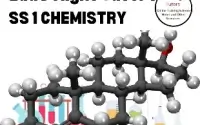Revision of All Topics Covered in SS1 Catering and Craft Practice SS 1 First Term Lesson Notes Week 12
Week 12: Revision of All Topics Covered in SS1 Catering and Craft Practice
Part A: Review and Revision (FAQs)
- What is catering?
Catering is the business of preparing and serving food and drinks to people. - What does the hospitality industry do?
It provides services like food, drinks, and accommodation to customers. - Who is a chef?
A chef is a person trained to cook food, especially in a restaurant or hotel. - What is the main aim of safety in the kitchen?
To prevent accidents and keep everyone safe. - Why is hygiene important in catering?
It prevents contamination and keeps food safe to eat. - What is cross-contamination?
It is when bacteria from raw food transfer to cooked food. - What is a catering establishment?
A place where food and drinks are prepared and served, like restaurants and hotels. - Why do we need sanitation in the kitchen?
Sanitation keeps the kitchen clean and reduces germs. - What is a glossary of culinary terms?
It is a list of words used in cooking with their meanings. - What is the purpose of a first aid box?
It provides items to treat minor injuries before getting medical help. - What are safety precautions?
Safety measures taken to avoid accidents. - What does food contamination mean?
When food becomes unsafe to eat due to germs or dirt. - What are culinary terms?
Words commonly used in cooking, like “boil,” “grill,” and “bake.” - What is food poisoning?
Illness caused by eating contaminated food. - What is the function of a fire extinguisher?
It helps to put out small fires quickly. - What does the term “personal hygiene” mean?
Personal hygiene involves keeping yourself clean to prevent spreading germs. - How does sanitation help in food preparation?
It ensures a clean environment for safe food handling. - What is the role of hospitality in catering?
It involves making guests comfortable with food, drinks, and services. - What kind of items should be in a first aid box?
Bandages, scissors, antiseptics, and gloves. - Why is it necessary to revise all topics before exams?
It helps in remembering what was learned and prepares students for assessments.
Part B: Objective Questions
Choose the correct option (a, b, c, or d) for each question.
- _____ is the business of preparing and serving food.
(a) Catering (b) Teaching (c) Driving (d) Traveling - The hospitality industry provides _____.
(a) books (b) clothing (c) food and accommodation (d) gadgets - A person who prepares food in a restaurant is called a _____.
(a) doctor (b) chef (c) teacher (d) cleaner - Kitchen safety helps to prevent _____.
(a) cooking (b) accidents (c) cleaning (d) washing - _____ hygiene is about keeping yourself clean.
(a) Personal (b) Group (c) Business (d) Environmental - A _____ is used to put out fires.
(a) mop (b) spoon (c) fire extinguisher (d) plate - Food contamination can lead to _____.
(a) good health (b) food poisoning (c) faster cooking (d) extra taste - A glossary helps people understand _____.
(a) foreign languages (b) cooking terms (c) school subjects (d) car parts - Cross-contamination occurs when germs move from _____.
(a) cooked food to raw food (b) raw food to cooked food (c) raw food to sink (d) cooked food to fire - First aid is given _____.
(a) before medical help arrives (b) after cooking (c) before cooking (d) during cleaning - A first aid box should include _____.
(a) clothes (b) scissors (c) pots (d) pans - The process of keeping the kitchen clean is called _____.
(a) cooking (b) sanitation (c) frying (d) storage - Food contamination can be avoided by _____.
(a) skipping meals (b) cooking well (c) storing raw and cooked foods together (d) using the same utensils) - Personal hygiene is important to _____.
(a) increase food taste (b) prevent germs spread (c) speed up cooking (d) reduce washing - A chef works in _____.
(a) a bank (b) a hospital (c) a kitchen (d) a classroom - Food poisoning is caused by _____.
(a) fresh food (b) contaminated food (c) healthy food (d) organic food - Sanitation includes keeping _____ clean.
(a) only the fridge (b) only the sink (c) all kitchen areas (d) only utensils - First aid helps to _____.
(a) improve food quality (b) prevent contamination (c) treat injuries (d) start cooking - A fire extinguisher is used to _____.
(a) cook faster (b) put out fires (c) wash dishes (d) refrigerate food - Cross-contamination occurs when _____ are shared between raw and cooked foods.
(a) containers (b) utensils (c) labels (d) shelves
Part C: Theory Questions
Answer each question briefly.
- What is catering?
- Define hospitality.
- Who is a chef?
- Why is hygiene important?
- What is cross-contamination?
- Name two items in a first aid box.
- What is the purpose of sanitation?
- Explain food contamination.
- Define culinary terms.
- What is a glossary?
- Describe one function of a fire extinguisher.
- List two catering establishments.
- Why is kitchen safety important?
- What does personal hygiene mean?
- Explain food poisoning.
- Why is sanitation important?
- Mention one aim of the hospitality industry.
- State one way to prevent cross-contamination.
- Describe a first aider.
- Explain the function of a glossary in catering.
Part D: True or False Questions
Write “True” or “False” for each statement.
- Catering involves serving food.
- A glossary lists words used in car parts.
- Kitchen safety can help prevent accidents.
- Cross-contamination is safe for food.
- First aid is given after medical help arrives.
- Hygiene prevents food contamination.
- Sanitation only refers to washing plates.
- The hospitality industry does not include hotels.
- First aid items include bandages and antiseptics.
- A chef usually works in a bank.
- Food contamination makes food unsafe to eat.
- Culinary terms are related to cooking.
- Fire extinguishers help to put out fires.
- Raw and cooked foods can share the same utensils safely.
- Food poisoning is caused by fresh food.
- A catering establishment serves food and drinks.
- Sanitation is not needed in the kitchen.
- Personal hygiene involves keeping hands clean.
- Cross-contamination can lead to food contamination.
- A glossary explains terms used in catering.
Part E: Fill-in-the-Gap Questions
Complete the sentences with the correct words.
- _____ involves preparing and serving food to people.
- The hospitality industry includes _____ and accommodation services.
- A _____ is a person who prepares food in restaurants.
- _____ hygiene involves washing hands before handling food.
- _____ helps to treat minor injuries quickly.
- Keeping cooking surfaces clean is part of _____.
- Cross-contamination happens when _____ from raw food spread to cooked food.
- Food poisoning is often caused by _____ food.
- _____ is used to put out fires in the kitchen.
- A glossary is a list of important _____ in cooking.
- Sanitation helps to reduce _____ in the kitchen.
- Personal hygiene prevents the spread of _____.
- A chef often works in a _____.
- Proper handwashing can stop the spread of _____.
- The hospitality industry also provides _____.
- A first aid box should contain items like _____ and scissors.
- Accidents in the kitchen can be prevented by following _____.
- First aid helps until _____ arrives.
- A glossary helps people understand _____ terms.
- Raw and cooked foods should not share the same _____.
This revision covers FAQs, objectives, theory, true/false, and fill-in-the-gap questions to reinforce knowledge and ensure students retain key concepts in catering and craft practice.
Related
Related posts:
- Catering and Craft Practice Scheme of Work for Senior Secondary Schools 1 Catering and Craft Practice SS 1 First Term Lesson Notes
- The Art of Catering: From History to Careers Catering and Craft Practice SS 1 First Term Lesson Notes Week 1
- Exploring the Hospitality Industry in Catering Catering and Craft Practice SS 1 First Term Lesson Notes Week 2
- Safety Precautions in the Kitchen Catering and Craft Practice SS 1 First Term Lesson Notes Week 8
- Meaning of First Aid, First Aider, First Aid Box, Fire Control, and Fire Lighting Equipment Catering and Craft Practice SS 1 First Term Lesson Notes Week 9
Related Posts
Kinds of Aquatic Habitat

Understanding Computer Types: A Comprehensive Guide Data Processing SS 1 First Term Lesson Notes Week 5

Understanding the Particulate Nature of Matter and Atomic Structure Chemistry SS 1 First Term Lesson Notes Week 4
About The Author
Edu Delight Tutors
Am a dedicated educator with a passion for learning and a keen interest in technology. I believe that technology can revolutionize education and am committed to creating an online hub of knowledge, inspiration, and growth for both educators and students. Welcome to Edu Delight Tutors, where learning knows no boundaries.